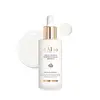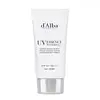What's inside
What's inside
 Key Ingredients
Key Ingredients

 Benefits
Benefits

 Concerns
Concerns

 Ingredients Side-by-side
Ingredients Side-by-side

Water
Skin ConditioningMethylpropanediol
SolventGlycerin
HumectantHydrogenated Polyisobutene
EmollientMethyl Gluceth-20
Humectant1,2-Hexanediol
Skin ConditioningLaminaria Japonica Extract
Skin ProtectingEclipta Prostrata Leaf Extract
Skin ConditioningPiper Methysticum Leaf/Root/Stem Extract
Skin ConditioningCollagen Extract
Skin ConditioningCentella Asiatica Extract
CleansingPhellodendron Amurense Bark Extract
Skin ConditioningTuber Magnatum Extract
Skin ConditioningTheobroma Cacao Seed Extract
AntioxidantAnemarrhena Asphodeloides Root Extract
Skin ConditioningSaccharum Officinarum Extract
MoisturisingHouttuynia Cordata Extract
Skin ConditioningLeontopodium Alpinum Extract
Skin ConditioningTilia Vulgaris Flower Extract
SoothingJasminum Officinale Flower Extract
MaskingChamaecyparis Obtusa Leaf Extract
Skin ConditioningHydrogenated Lecithin
EmulsifyingCitrus Aurantium Dulcis Oil
MaskingPersea Gratissima Oil
Skin ConditioningOlea Europaea Fruit Oil
MaskingHelianthus Annuus Seed Oil
EmollientCitrus Nobilis Peel Oil
MaskingLitsea Cubeba Fruit Oil
MaskingOenothera Biennis Oil
EmollientGlycine Soja Oil
EmollientCamellia Japonica Seed Oil
EmollientMacadamia Ternifolia Seed Oil
EmollientHippophae Rhamnoides Fruit Oil
Skin ProtectingSodium Hyaluronate
HumectantBetula Platyphylla Japonica Juice
Skin ConditioningCananga Odorata Flower Oil
MaskingCeteareth-20
CleansingGlyceryl Stearate Se
EmulsifyingAcrylates/C10-30 Alkyl Acrylate Crosspolymer
Emulsion StabilisingTromethamine
BufferingButylene Glycol
HumectantTocopheryl Acetate
AntioxidantPanthenol
Skin ConditioningXanthan Gum
EmulsifyingGlyceryl Polymethacrylate
Adenosine
Skin ConditioningFructooligosaccharides
HumectantBeta-Glucan
Skin ConditioningCeramide NP
Skin ConditioningHydrolyzed Hyaluronic Acid
HumectantDextrin
AbsorbentHydrolyzed Sodium Hyaluronate
Skin ConditioningXylitylglucoside
HumectantAnhydroxylitol
HumectantXylitol
HumectantGlucose
HumectantMannose
HumectantHydroxypropyltrimonium Hyaluronate
Tocopherol
AntioxidantSodium Acetylated Hyaluronate
HumectantSodium Hyaluronate Crosspolymer
HumectantPotassium Hyaluronate
Skin ConditioningHyaluronic Acid
HumectantHydroxyacetophenone
AntioxidantLimonene
PerfumingCitral
PerfumingWater, Methylpropanediol, Glycerin, Hydrogenated Polyisobutene, Methyl Gluceth-20, 1,2-Hexanediol, Laminaria Japonica Extract, Eclipta Prostrata Leaf Extract, Piper Methysticum Leaf/Root/Stem Extract, Collagen Extract, Centella Asiatica Extract, Phellodendron Amurense Bark Extract, Tuber Magnatum Extract, Theobroma Cacao Seed Extract, Anemarrhena Asphodeloides Root Extract, Saccharum Officinarum Extract, Houttuynia Cordata Extract, Leontopodium Alpinum Extract, Tilia Vulgaris Flower Extract, Jasminum Officinale Flower Extract, Chamaecyparis Obtusa Leaf Extract, Hydrogenated Lecithin, Citrus Aurantium Dulcis Oil, Persea Gratissima Oil, Olea Europaea Fruit Oil, Helianthus Annuus Seed Oil, Citrus Nobilis Peel Oil, Litsea Cubeba Fruit Oil, Oenothera Biennis Oil, Glycine Soja Oil, Camellia Japonica Seed Oil, Macadamia Ternifolia Seed Oil, Hippophae Rhamnoides Fruit Oil, Sodium Hyaluronate, Betula Platyphylla Japonica Juice, Cananga Odorata Flower Oil, Ceteareth-20, Glyceryl Stearate Se, Acrylates/C10-30 Alkyl Acrylate Crosspolymer, Tromethamine, Butylene Glycol, Tocopheryl Acetate, Panthenol, Xanthan Gum, Glyceryl Polymethacrylate, Adenosine, Fructooligosaccharides, Beta-Glucan, Ceramide NP, Hydrolyzed Hyaluronic Acid, Dextrin, Hydrolyzed Sodium Hyaluronate, Xylitylglucoside, Anhydroxylitol, Xylitol, Glucose, Mannose, Hydroxypropyltrimonium Hyaluronate, Tocopherol, Sodium Acetylated Hyaluronate, Sodium Hyaluronate Crosspolymer, Potassium Hyaluronate, Hyaluronic Acid, Hydroxyacetophenone, Limonene, Citral
Homosalate
Skin ConditioningOctocrylene
UV AbsorberEthylhexyl Methoxycinnamate
UV AbsorberEthylhexyl Salicylate
UV AbsorberButyl Methoxydibenzoylmethane
UV AbsorberWater
Skin ConditioningPropanediol
SolventButyloctyl Salicylate
Skin ConditioningCeramide AP
Skin Conditioning1,2-Hexanediol
Skin ConditioningPentylene Glycol
Skin ConditioningSilica
AbrasiveDimethicone/Vinyl Dimethicone Crosspolymer
Skin ConditioningAmmonium Acryloyldimethyltaurate/Vp Copolymer
Glycerin
HumectantVp/Eicosene Copolymer
Hippophae Rhamnoides Fruit Oil
Skin ProtectingPolyurethane-15
Citrus Aurantium Dulcis Oil
MaskingInulin Lauryl Carbamate
Emulsion StabilisingPolyacrylate Crosspolymer-6
Emulsion StabilisingHydroxypropyl Methylcellulose Stearoxy Ether
Ethylhexylglycerin
Skin ConditioningCitrus Nobilis Peel Oil
MaskingButylene Glycol
HumectantLitsea Cubeba Fruit Oil
MaskingBHT
AntioxidantTocopherol
AntioxidantPanthenol
Skin ConditioningCeramide NP
Skin ConditioningHydrolyzed Sodium Hyaluronate
Skin ConditioningSodium Hyaluronate
HumectantMelaleuca Alternifolia Leaf Water
AntimicrobialCentella Asiatica Leaf Extract
Skin ConditioningCentella Asiatica Extract
CleansingHomosalate, Octocrylene, Ethylhexyl Methoxycinnamate, Ethylhexyl Salicylate, Butyl Methoxydibenzoylmethane, Water, Propanediol, Butyloctyl Salicylate, Ceramide AP, 1,2-Hexanediol, Pentylene Glycol, Silica, Dimethicone/Vinyl Dimethicone Crosspolymer, Ammonium Acryloyldimethyltaurate/Vp Copolymer, Glycerin, Vp/Eicosene Copolymer, Hippophae Rhamnoides Fruit Oil, Polyurethane-15, Citrus Aurantium Dulcis Oil, Inulin Lauryl Carbamate, Polyacrylate Crosspolymer-6, Hydroxypropyl Methylcellulose Stearoxy Ether, Ethylhexylglycerin, Citrus Nobilis Peel Oil, Butylene Glycol, Litsea Cubeba Fruit Oil, BHT, Tocopherol, Panthenol, Ceramide NP, Hydrolyzed Sodium Hyaluronate, Sodium Hyaluronate, Melaleuca Alternifolia Leaf Water, Centella Asiatica Leaf Extract, Centella Asiatica Extract
 Reviews
Reviews

Ingredients Explained
These ingredients are found in both products.
Ingredients higher up in an ingredient list are typically present in a larger amount.
1,2-Hexanediol is a synthetic liquid and another multi-functional powerhouse.
It is a:
- Humectant, drawing moisture into the skin
- Emollient, helping to soften skin
- Solvent, dispersing and stabilizing formulas
- Preservative booster, enhancing the antimicrobial activity of other preservatives
Butylene Glycol (or BG) is used within cosmetic products for a few different reasons:
Overall, Butylene Glycol is a safe and well-rounded ingredient that works well with other ingredients.
Though this ingredient works well with most skin types, some people with sensitive skin may experience a reaction such as allergic rashes, closed comedones, or itchiness.
Learn more about Butylene GlycolCentella Asiatica Extract (Centella) is derived from an herb native to Southeast Asia. It is famous for its anti-inflammatory and soothing properties.
Centella is rich in antioxidants and amino acids, such as Madecassic Acid and Asiaticoside.
Studies show the compounds in centella help with:
The combination of all these properties makes centella effective at soothing, hydrating, and protecting the skin.
Other great components of centella include Vitamin A, vitamin C, several B vitamins, and Asiatic Acid.
Fun fact: Centella has been used as a medicine and in food for many centuries. As a medicine, it is used to treat burns, scratches, and wounds.
Learn more about Centella Asiatica ExtractCeramide NP is a type of ceramide and formally known as ceramide 3.
Ceramides are intercellular lipids naturally found in our skin that bonds dead skin cells together to create a barrier. They are known for their ability to hold water and thus are a great ingredient for dry skin.
Ceramides are an important building block for our skin barrier. A stronger barrier helps the skin look more firm and hydrated. By bolstering the skin ceramides act as a barrier against irritating ingredients. This can help with inflammation as well.
If you would like to eat ceramides, sweet potatoes contain a small amount.
Read more about other common types of ceramides here:
Ceramide AP
Ceramide EOP
Citrus Aurantium Dulcis Oil comes from the bitter orange, an orange native to Southeast Asia.
This orange is commonly used in cosmetics and food. It is a common ingredient for marmalade.
Citrus peels are often made up of mainly limonene, a fragrance with a citrus scent. They also contain flavonoids, which have anti-inflammatory properties.
Learn more about Citrus Aurantium Dulcis OilCitrus Nobilis Peel Oil is an oil.
Glycerin is already naturally found in your skin. It helps moisturize and protect your skin.
A study from 2016 found glycerin to be more effective as a humectant than AHAs and hyaluronic acid.
As a humectant, it helps the skin stay hydrated by pulling moisture to your skin. The low molecular weight of glycerin allows it to pull moisture into the deeper layers of your skin.
Hydrated skin improves your skin barrier; Your skin barrier helps protect against irritants and bacteria.
Glycerin has also been found to have antimicrobial and antiviral properties. Due to these properties, glycerin is often used in wound and burn treatments.
In cosmetics, glycerin is usually derived from plants such as soybean or palm. However, it can also be sourced from animals, such as tallow or animal fat.
This ingredient is organic, colorless, odorless, and non-toxic.
Glycerin is the name for this ingredient in American English. British English uses Glycerol/Glycerine.
Learn more about GlycerinHippophae Rhamnoides Fruit Oil comes from the seabuckthorn berry. The seabuckthorn fruit contains carotenoids, palmitic acid, palmitoleic acid and vitamin E.
The nutritious content of seabuckthorn fruit oil helps hydrate and nourish the skin. A study from 2018 found seabuckthorn may help with alleviating UV damage due to its anti-inflammatory property.
Carotenoids and Vitamin E help nourish your skin's natural barrier. This barrier protects your skin and is responsible for firm skin.
Learn more about Hippophae Rhamnoides Fruit OilThis ingredient is created by putting sodium hyaluronate through hydrolysis.
You might know this as 'mini' or 'ultra low-molecular weight' hyaluronic acid. The small molecule size means it is able to travel deeper in the skin.
According to studies, low molecular-weight hyaluronic acid can:
One study from 2011 found ultra-low weight HA to show pro-inflammatory properties. Another study from 2022 found it to downregulate UV-B induced inflammation.
Hydrolysis is a process of changing a molecule using water or enzymes.
This ingredient is water-soluble.
Learn more about Hydrolyzed Sodium HyaluronateLitsea Cubeba Fruit Oil is a fragrance and is an oil.
Panthenol is a common ingredient that helps hydrate and soothe the skin. It is found naturally in our skin and hair.
There are two forms of panthenol: D and L.
D-panthenol is also known as dexpanthenol. Most cosmetics use dexpanthenol or a mixture of D and L-panthenol.
Panthenol is famous due to its ability to go deeper into the skin's layers. Using this ingredient has numerous pros (and no cons):
Like hyaluronic acid, panthenol is a humectant. Humectants are able to bind and hold large amounts of water to keep skin hydrated.
This ingredient works well for wound healing. It works by increasing tissue in the wound and helps close open wounds.
Once oxidized, panthenol converts to pantothenic acid. Panthothenic acid is found in all living cells.
This ingredient is also referred to as pro-vitamin B5.
Learn more about PanthenolSodium Hyaluronate is hyaluronic acid's salt form. It is commonly derived from the sodium salt of hyaluronic acid.
Like hyaluronic acid, it is great at holding water and acts as a humectant. This makes it a great skin hydrating ingredient.
Sodium Hyaluronate is naturally occurring in our bodies and is mostly found in eye fluid and joints.
These are some other common types of Hyaluronic Acid:
Learn more about Sodium HyaluronateTocopherol (also known as Vitamin E) is a common antioxidant used to help protect the skin from free-radicals and strengthen the skin barrier. It's also fat soluble - this means our skin is great at absorbing it.
Vitamin E also helps keep your natural skin lipids healthy. Your lipid skin barrier naturally consists of lipids, ceramides, and fatty acids. Vitamin E offers extra protection for your skin’s lipid barrier, keeping your skin healthy and nourished.
Another benefit is a bit of UV protection. Vitamin E helps reduce the damage caused by UVB rays. (It should not replace your sunscreen). Combining it with Vitamin C can decrease sunburned cells and hyperpigmentation after UV exposure.
You might have noticed Vitamin E + C often paired together. This is because it is great at stabilizing Vitamin C. Using the two together helps increase the effectiveness of both ingredients.
There are often claims that Vitamin E can reduce/prevent scarring, but these claims haven't been confirmed by scientific research.
Learn more about TocopherolWater. It's the most common cosmetic ingredient of all. You'll usually see it at the top of ingredient lists, meaning that it makes up the largest part of the product.
So why is it so popular? Water most often acts as a solvent - this means that it helps dissolve other ingredients into the formulation.
You'll also recognize water as that liquid we all need to stay alive. If you see this, drink a glass of water. Stay hydrated!
Learn more about Water